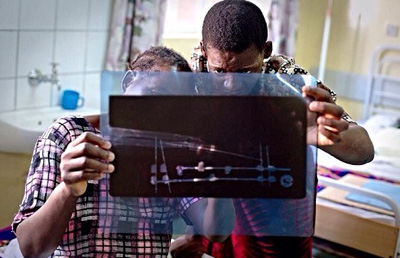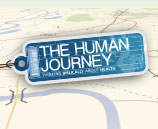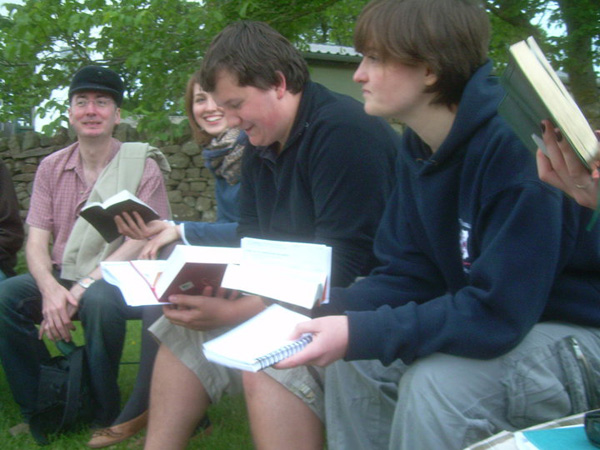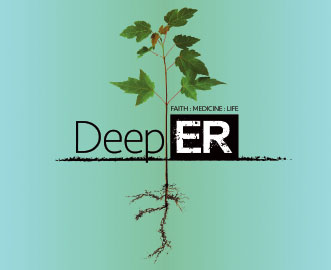In March I arrived bleary eyed but excited in Malawi after about 18 hours of travelling. I felt rather disorientated flying into Blantyre as all I could see from the window was green. I flew in via Johannesburg which had been cold and wet so I had felt quite at home, but the lush vegetation of Malawi was a bit overwhelming after living in the concrete jungle that is London for the previous 6 months.

I was to spend the next 2 months at the Beit CURE International Hospital in Blantyre which is in the middle of Southern Malawi. The hospital specialises in providing excellence in orthopaedic care with facilities and treatment of a Western standard. The hospital is heavily involved in teaching and training doctors from both Malawi and elsewhere in Africa. All treatment for children is free, and the hospital offers a private service for adults to fund the children's operations. The hospital treats a wide variety of orthopaedic conditions, with many patients travelling from all over Malawi or even the surrounding countries to be seen. The staff are mainly Malawian, although they have several surgeons from the UK, USA and Kenya. Each year the hospital sees about 8,000 patients and performs 1,000 operations.
I was met at the airport by Dr Dave Burgess, the Medical Director at the hospital. On the way to CURE I heard all about the hospital and how Dave and his wife Margie had come to work in Malawi from the US. On arrival I was introduced to another orthopaedic surgeon and shown round the hospital. We had orientation on my first morning, where I learnt some dos and don'ts - do ask how someone is when you great them, don't show your knees (apparently people used to get put in jail!). Over the next few days I got to meet lots of staff members and learn how the hospital worked. There are two teams of surgeons and I was attached to Dr Burgess's, attending his theatre lists, ward rounds and clinics.

On my first Sunday I met up with the missionaries from my church in Manchester and went to church with them. It was in one of the townships on the outskirts of Blantyre, in a single roomed concrete building. Inside were wooden benches and a lectern, from which the leader would frequently cry "alleluia!" to which we all replied "amen!” The service was in Chichewa, so we had no idea what was being said, but at one point we had to stand up and be introduced, which was followed by having to go up to the front while the entire congregation came to shake our hands! That was the first of three hand-shaking occasions that service! There was also lots of singing, with about 4 different choirs going up and performing 3 songs each. Jo kindly translated some of what was going on for us. There was great joy in the church however, and we certainly didn't suffer from lack of instruments or other trimmings. I thoroughly enjoyed it and was reminded how global the church is.
After church we had lunch with the missionaries, and then went to climb one of Blantyre's many hills. This one was in a Catholic area, and there were Stations of the Cross along the route. At the top we got an amazing view over Blantyre, as well as meeting some monks and nuns having a meeting at the foot of the cross.My first full week in the hospital was quite a learning curve. The ward round included a few spot diagnoses I have never heard of before let alone seen. I saw one patient with Ollier's disease who had multiple benign cartilaginous tumours on her knees, hips and shoulders. In clinic I saw amniotic band syndrome, as well as multiple cases of polydactyly, Perthes' disease, knock knees and bow legs. There was also a little boy whose arm got bitten by a crocodile. To the left is a picture of his parents looking at an x-ray of his arm. He had significant osteomyelitis and had to have a fixator on for the several months as his wrist had been crushed by the crocodile bite. He was in hospital for my first 6 weeks, and it was great to see him improve and the fixator come off. He had been discharged by the time I left and was returning to CURE for outpatient physio appointments.

In my first week I went to theatre and saw a total hip replacement, something I never got to see on my orthopaedics placement in Medical School. I was really impressed with the theatres at CURE, which were not unlike those in the hospitals I have trained in. Dr Burgess was training a Malawian surgeon who was the equivalent of a registrar in the UK. Previously many Malawians have had to seek post-graduate training outside of Malawi, so fellowships like those offered at CURE are really important for keeping doctors in the country and training them to a high standard.
Over the next couple of weeks I began to get better at diagnosing patients in clinic, and helping out on ward rounds. I became able to differentiate between idiopathic bow legs and rickets, as well as improving my examination skills. I enjoyed spending time in theatre getting to know the staff and seeing lots of operations that I haven't had the opportunity to see in the UK. I felt that the surgeons were quite resourceful, for example using sterile glove paper to mark out skin graft sizes. Honey was also used for its antimicrobial properties in a lot of the wound dressings, often being poured directly into a bone after it had been debrided of dead tissue.
Along with my increasing knowledge of orthopaedic conditions I also learnt more about treating tropical diseases and minor injuries, mostly on myself! Malawi was full of insects and I suffered particularly with tea fly bites when I visited one of the tea plantations. I also learnt how to treat severe sunburn after a hiking trip to visit a waterfall left me lobster red. A mixed blessing that came from this was my bites didn't itch on the burnt bits! In my second week I managed to trap my thumb in a car door, resulting in a very large and painful haematoma which had to be drained. Finally a visit to Lake Malawi lead to a course of praziquantel as the lake is infested with schistosomiasis. As I have been considering a career serving in a developing country it was helpful to see the realities of the other parts of life that I would have to deal with aside from the poverty, culture shock and language barrier.
CURE is a Christian charity and what I really liked about the hospital is how 50% of what they do is medical and 50% is spiritual. There is a spiritual team who pray with patients and together with the clinical staff provide truly holistic care. Each day the staff meet in devotional groups to pray, worship or study the bible. Every Tuesday everyone meets together to worship and someone gave a short talk. One Tuesday Lone (a volunteer from Denmark) and I were asked to lead the talk for the morning meeting for the whole hospital. The theme was Easter and to begin with our group stood at the front and lead everyone in a song, which was about Jesus' triumphant entry into Jerusalem. I then spoke about how we can know Jesus loves us because of the cross, because he took our place and bore the punishment we deserved. Lone finished by reminding us how he has risen and gone ahead of us. I think it went well, someone commented that they didn't realise I was a preacher, and I replied neither did I!
On Tuesday mornings I attended clinic and saw all kinds of weird and wonderful bony deformities. There were several patients with advanced clubfoot, cerebral palsy and query neurofibromatosis. One week I saw a girl with an 11cm leg length discrepancy, another whose foot was so deformed that it was almost twisted upside down. The most shocking case however was a girl whose lower leg was complexly twisted so that her foot was backwards (see x-ray). Blount's disease is far more common in Malawi than it is in the West and I saw several patients with varying degrees of severity. The picture on the right is of a boy with advanced Blount's disease before he went to theatre. He had an osteotomy to correct his deformity. Many of these patients will have been completely ostracised in their communities and have far fewer opportunities educationally and socially. Fortunately the surgeons and physiotherapists at CURE can help treat many of the conditions I saw, and make a massive difference to these children's lives.
I particularly enjoyed the plastics that I saw in Malawi, and the best days were when I got to assist in theatre. For example one day I helped with a burns contracture release and full thickness skin graft on a little girl who couldn't open her hand due to the scar tissue. I got to learn how to take a skin graft, and when it is appropriate to use full-thickness opposed to a split-thickness graft. I was also given the opportunity to practice my suturing by closing a graft site and suturing the graft in place. I have been thinking about a career in paediatric surgery for several years however my experiences in Malawi have prompted me to investigate plastic surgery further, particularly for burns victims.
This kind of reconstructive surgery can have a huge impact on quality of life in these children, and enable to them to use their hands again and learn to write. Burns contractures are a big problem in Malawi as many people cook on open fires and in the colder season children sleep close to the fire to keep warm. One particular operation took 8 hours to release the fingers, remove the scar tissue, bring the tendons back into place and then create a radio-forearm skin flap to cover the back of the hand. A split thickness skin graft was taken from the thigh to cover up the gap in the forearm. It was exhausting watching it, let alone operating but for Tito it will be life changing. He had burnt both hands in a fire and had been unable to use them for several years. Fortunately he was up and about, running all over the hospital a few days after his operation. Hopefully now he will regain some function in this hand while he awaits the second operation on his other hand.
I spent Thursday mornings in the clubfoot clinic, learning how to assess severity, and the Ponsetti method of serial casting to help correct the deformity (see before and after pictures below). I even got to have a go plastering a foot, which was very messy but good fun! During my time in Malawi I learnt more and more about how vital the role of a physiotherapist is there. In clinic about 60% of the patients we saw were referred to physio, and for many of them the hard work of the surgeons would be wasted without proper stretching and strengthening rehabilitation before and afterwards. There is a great team here, although they are sometimes overwhelmed by the numbers who need their help. This is particularly the case with children with cerebral palsy. Many come to CURE for physio which they desperately need, however CUREs remit is orthopaedic problems, and all their time and resources are spent helping these children. There is therefore a tension in what CURE can provide as if the children with cerebral palsy don't get physio here, they won't get it anywhere else. Malawi is beginning to train up more physios, with the first cohort of students graduating this summer. I have met some of the students have come to CURE and many of them are unsure of what their career will look like, with such a shortage of role models.
I had a fantastic 2 months in Malawi and I think that it has definitely had a lasting impact on me. I had chosen to go to the CURE hospital as I wanted to get more experience of medical mission in the developing world. I enjoyed that the hospital in Blantyre was quite small, enabling me to get to know lots of the staff from doctors, nurses, chaplains, receptionists, researches, administrators and hospital drivers. I loved walking down a corridor and being able to stop and chat to the people I passed. Being a Christian hospital gave it a sense of unity and it was such privilege to be able to pray for patients before they went to theatre.
However life in Malawi was not without challenges and frustrations. I found loneliness difficult, especially as the volunteer community is quite transient. I also had several problems with my bank card not working and a power cut at the immigration office making getting a visa extension quite stressful. I felt I grew up quite a lot while I was away and had to deal with and overcome difficulties by myself which I would have asked for help if I was at home. All these things have been valuable lessons and things that I need to consider if I do work overseas long term in the future.
Working aboard is definitely still something that I am working towards. I am so grateful for the opportunity to visit Malawi and see the fantastic job that the CURE hospital does. I would love to visit Malawi again one day, perhaps even as a plastic surgeon!































